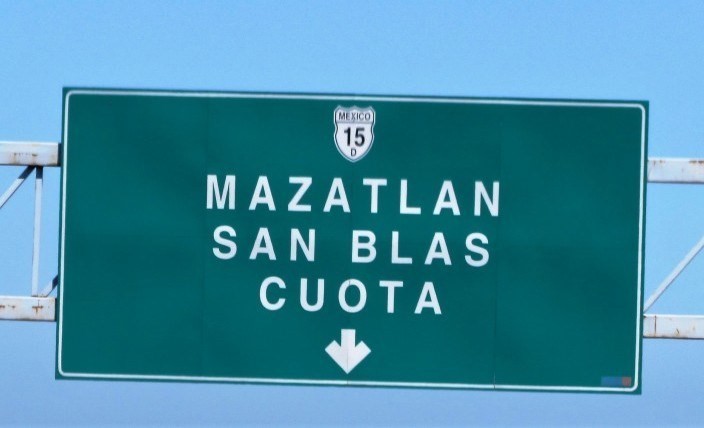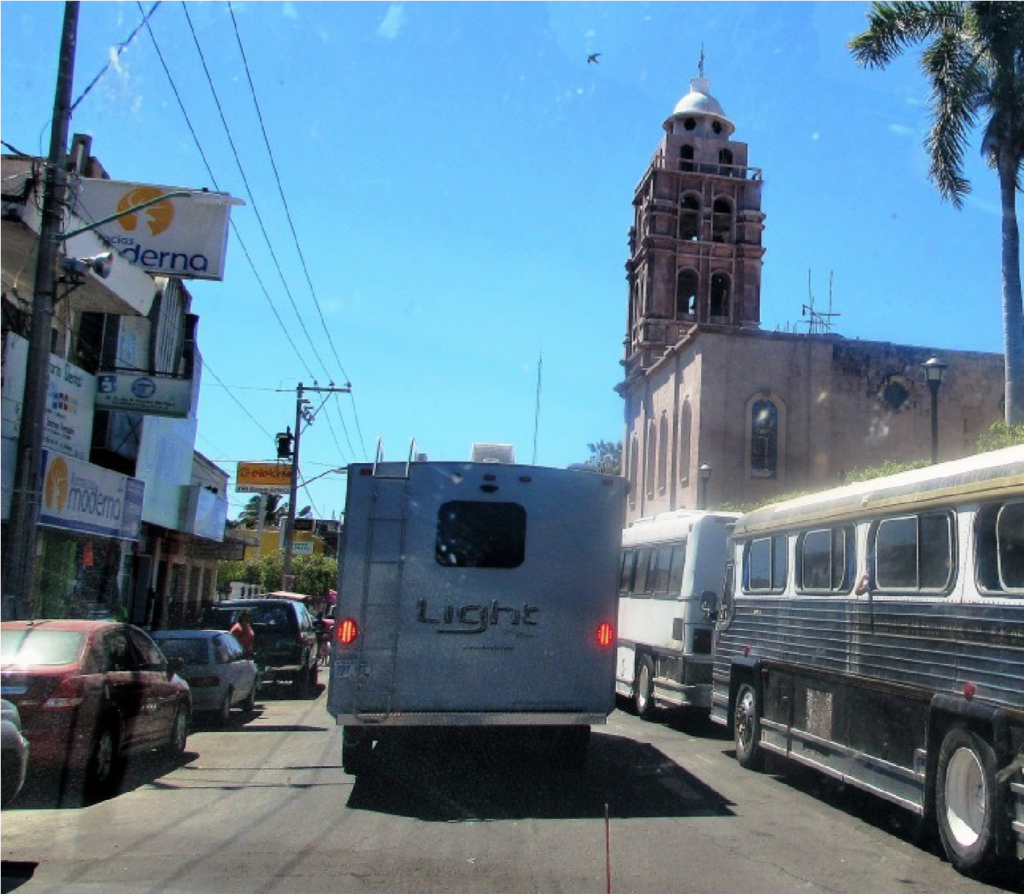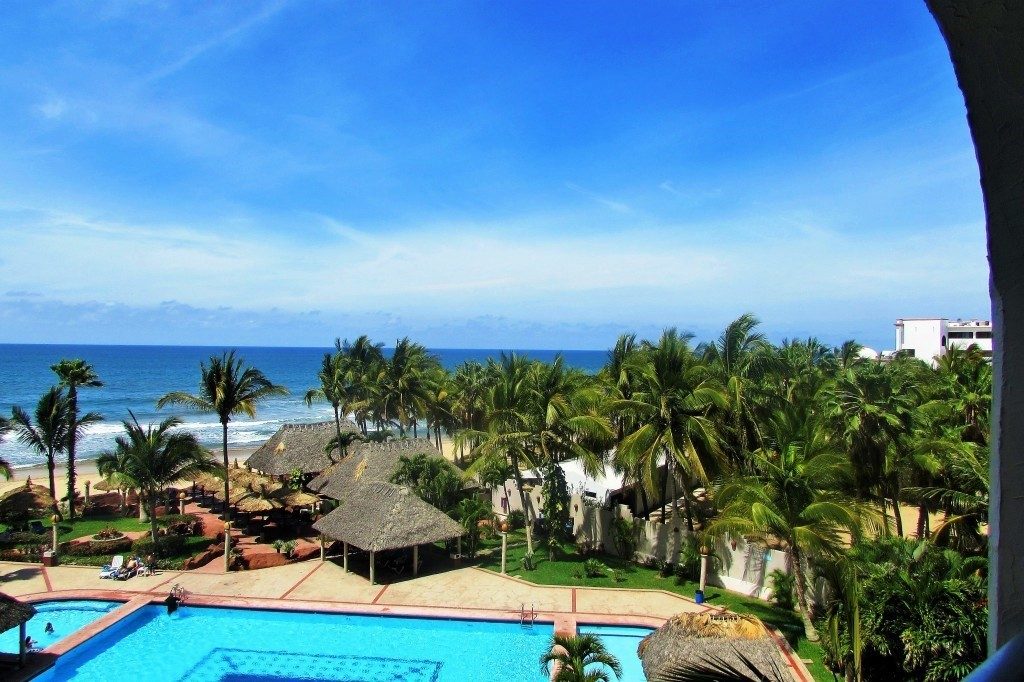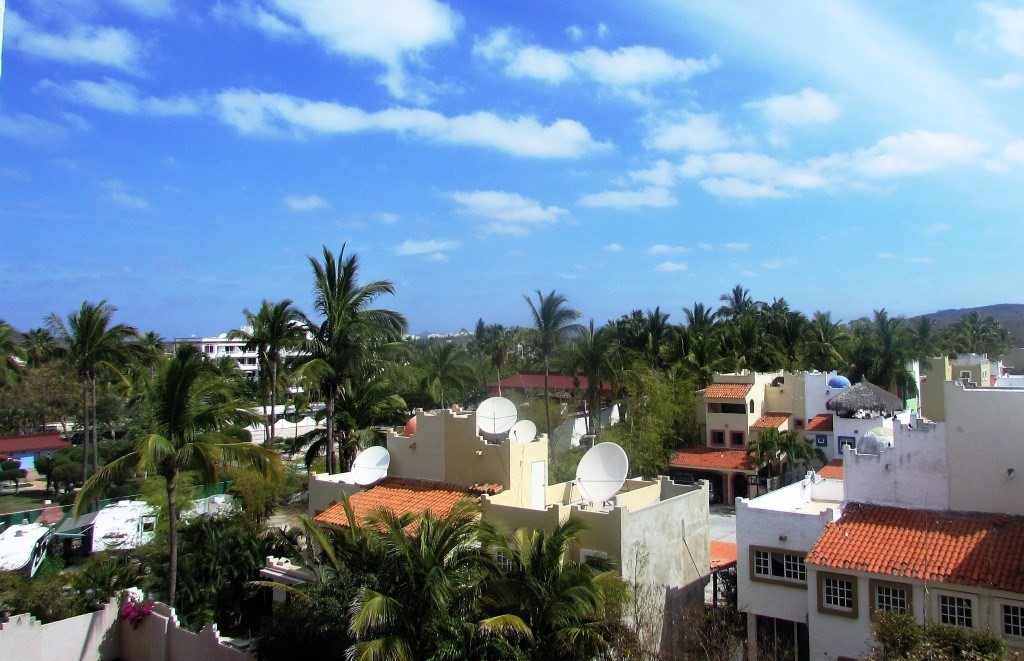By Dan and Lisa Goy from the February 2019 Edition
February 2019
March 28 -29, 2016 (Days 82-83)
Mazatlán, Sinaloa

Next up was our 542 km (almost 400 miles) drive to Mazatlán, Sinaloa. Mike and Kelly were in lead and, yes, we had a couple of glitches early on. First, the entrance to northbound Periférico was closed which caused just a short delay as we needed to find a return. As we reached our last leg to Mazatlán, the last 80 km of 15D Cuota highway was closed by police, which was unfortunate as we had just paid a hefty toll to be on it and this made the last bit of our long day longer.

We landed at the Punta Cerritos RV Park late in the afternoon. At first they only had two spots available then, after the others got parked, another spot (#5) became available, at the waterfront near the pool. That worked out well. We had planned for dinner at 6pm with Eric and Sandra (Surrey friends who winter at a nearby condo) at Roy’s Restaurant in the plaza next to the RV Park. Eric recommended Los Cerritos campground as the meeting place was next door. Dinner was great and we all had fun catching up on our respective time in Mexico. The next day Lisa and I walked down to the beachfront condo where Eric and Sandra were staying. Great view, nice beach, wonderful pool and a very nice apartment.

Eric goes boogey boarding daily and has swim in the pool. What a great way to sit out January, February and March in Surrey each year! After our visit, we all walked up the beach back to the RV Park and spent the remainder of the day poolside and had a surprise visit from Paul Beddows, my Cara vans de Mexico buddy. Paul was with some members of his group and scheduled to be out of Mexico on April 1. Later, the gang all went for dinner at the “Bruja” Restaurant, a short walk around the corner and down the street on the ocean. The musician was pretty good, the clown kinda creepy and the food was ok.

Good signage on the way into town via Hwy 15D The free highway (libre) into Mazatlán Above and below: Eric and Sandra’s views from their condo Coastal Mexico’s Lifestyle eMagazine manzanillosun.com 27
Note: we have recently returned to Mazatlán with our recent 4-day mainland Mexico RV Tour and we visited the Los Cerritos RV Park. There were a few RV camping spots in the park in 2016 and that is no longer the case. All RV spaces are now per-manent, no more camping. Our Caravan RV Tour stayed at “Las Jaibas” RV Park down the same road. Our guess is this will not be around much longer as new development surrounds that campground. This north end of Mazatlán is very active for development with probably 20 projects on the go. On our return in March 2019, we will be staying at the Barakas Villa and Beach Club which, it appears, will be around in the future.
Did you know?
Mazatlán is a Nahuatl word meaning “place of deer”. The city was founded in 1531 by an army of Spaniards and indigenous settlers. By the mid19th century, a large group of immigrants ad arrived from Germany. These new citizens developed Mazatlán into a thriving commercial seaport, importing equipment for the nearby gold and silver mines. It served as the capital of Sinaloa from 1859 to 1873. The German settlers also influenced
the local music, banda, which is an alteration of Bavarian folk music. The settlers also established the Pacífico Brewery on March 14, 1900.
History
Mazatlán early settlers
Indigenous groups were in the region of Mazatlán prior to the arrival of the Spanish. These groups included the Totorames, who lived from the south bank of the Río Piaxtla, to the Río de las Cañas, as well as the Xiximes, who lived in the mountains in the bordering state of Durango. Until the early 19th century, Mazatlán was a collection of huts inhabited by indigenous people whose major occupation was fishing, according to Abel Aubert du Petit-Thouars, a French explorer.
The Malecón of Mazatlán
It is considered one of the longest in the world, has a length of about 21 km, along the Pacific coast, among which you can find from high cliffs, monuments, gazebos, old buildings, hotels, etc. The Malecón in Mazatlán is composed of a series of scenic roads, with pedestrian space, whose name varies along the route by stage or time of construction.
Invasions
Between 1847 and 1848, Mazatlán was invaded and occupied by the US military In order to avoid the shelling of the city, the Mexican army abandoned it. Unfortunately, weakening Mexico’s cause in the north was internal rebellion and insurrection. The former president, Anastasio Bustamente, was put in command of an expedition that was supposed to counter US intrusions into California but, before Bustamente’s force got as far as Guadalajara, insurrection intervened. And at Mazatlán, the port from which Bustamente’s force was supposed to debark, civil war erupted, making departure impossible.Ten years later, in 1859, the port was blockaded by the Brit-ish warship Amethyst when the resident English Consul was imprisoned. The Amethyst threatened to bombard Mazatlán unless the Consul was released and funds seized from him re-turned. The siege was lifted in May 1859 and conflict was resolved.On the morning of November 13, 1864 the French Navy ships fired twelve cannon shots into the city causing minor damage to several homes but causing no deaths.
The attack stopped when the prefect of the city made known to the invaders that the Mexican Army had left the square and he formally handed it over to them. The takeover of the city was preceded by a naval blockade dating from mid-April 1864 and a four way oligarchy regarding the control of the city within the Juarista party. French troops landed with a force of 5000 soldiers and seized the city. One American citizen was shot on sight. Advocate for surrender, General Corona, tried to retake the city three times unsuccessfully in 1866. Finally, on November 13, 1866, Mexican General Ramón Corona expelled the French forces from Mazatlán.
On June 18, 1868, William H. Bridge, captain of HMS Chanti cleer, blockaded the port and threatened to shell the city on June 22 The captain had taken umbrage after local customs authorities seized 23 ounces of gold from the paymaster of his Porfiriato
Mazatlán’s lighthouse (El Faro) began operating in mid-1879
The maritime signals were manufactured in Paris, France, containing a large oil lamp with mirrors, and a Fresnel lens to focus the light. Since the light was static, from a distance it was often mistaken for a star. By 1905, this lamp was converted to a revolving lamp. During that period, the Mazatlán lighthouse was considered to be the naturally highest one in the world.
Today, the 1000
Watt bulb can be seen for 30 nautical miles (60 km). Near the lighthouse shore, famous “divers” (called this
even by the Spanish speaking inhabitants of Mazatlán) perform daring jumps off high rocks into the Pacific Ocean, for tips from onlooking tourists.
On June 26, 1880, Jesús Ramírez, former general in command of 400 men, stormed the garrison of the square and
appropriated Mazatlán. After imposing a compulsory loan on traders, locals had to leave the city when it was bombed again by the Democratic Mexican warship, which caused a high number of women and children to be killed or wounded. Of the 24 cannon shots fired, only three hit the intended headquarters of Ramírez and the rest landed on the neighboring houses.
Mexican Revolution
In 1912, the municipalities enacted law No. 21 as a form of internal division of the State. However, it wasn’t until 1915 that the law was abolished by the political directorate, when it erected the first free communes. With the publication of the decree creating the municipality of Mazatlán in the official newspaper on April 8, 1915, independent life began in the region. The Constitution of 1917, culminating in the first constitutional governor, General Ramón F. Iturbe, born in Mazatlán, confirmed the sixteen municipalities into which the state was divided, which would then be subdivided into receiverships and police precincts. The City of Mazatlán has the dubious distinction of being the second city in the world, after Tripoli, Libya to suffer aerial bombardment (although the local historical display at the plazuela claims that Mazatlán was the first). During the Mexican
Revolution, General Venustiano Carranza (later president), intent on taking the city of Mazatlán, ordered a biplane to drop a crude bomb of nails and dynamite, wrapped in leather, on the target of Nevería Hill adjacent to the downtown area of Mazatlán. The crude bomb landed off target on the city streets of azatlán, killing two citizens and wounding several others.
The full edition or view it online
Dan and Lisa Goy, owners of Baja Amigos RV Caravan Tours, have been making Mexico their second home for more than 30 years and love to introduce Mexico to newcomers.



